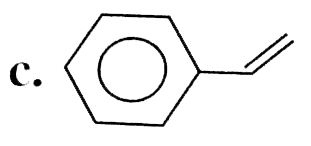In which case will SE not be in m− position?




The correct Answer is:a
To determine in which case the electrophilic substitution (SE) will not occur at the meta position, we need to analyze the substituents attached to the benzene ring. The key is to identify whether the substituents are electron-donating or electron-withdrawing and their directing effects on electrophilic substitution reactions.
1. Identify the Substituents: We need to look at the groups attached to the benzene ring in each case. The groups mentioned are COO, a quaternary amine, ethene, and CF3.
2. Analyze Each Group:
- Group A (COO): This is a carboxylate group, which is an electron-withdrawing group. Electron-withdrawing groups direct electrophilic substitution to the meta position. Therefore, this group does not satisfy our condition as it directs to the meta position.
- Group B (Quaternary Amine): This group is also an electron-withdrawing group. Like the carboxylate group, it will also direct electrophilic substitution to the meta position. Thus, this group cannot be our answer either.
- Group C (Ethene): Ethene is a double bond that can act as a deactivating group but it is also ortho-para directing. This means that it will not direct the electrophile to the meta position. Therefore, this group is a candidate for our answer.
- Group D (CF3): The trifluoromethyl group (CF3) is a strong electron-withdrawing group. It directs electrophilic substitution to the meta position, similar to the previous two groups. Hence, this group cannot be our answer.
3. Conclusion: The only substituent that does not direct electrophilic substitution to the meta position is the ethene group (Group C). Therefore, the answer to the question is option C.
Final Answer:
The electrophilic substitution will not occur at the meta position in the case of option C (Ethene).
---
- Group A (COO): This is a carboxylate group, which is an electron-withdrawing group. Electron-withdrawing groups direct electrophilic substitution to the meta position. Therefore, this group does not satisfy our condition as it directs to the meta position.
- Group B (Quaternary Amine): This group is also an electron-withdrawing group. Like the carboxylate group, it will also direct electrophilic substitution to the meta position. Thus, this group cannot be our answer either.
- Group C (Ethene): Ethene is a double bond that can act as a deactivating group but it is also ortho-para directing. This means that it will not direct the electrophile to the meta position. Therefore, this group is a candidate for our answer.
- Group D (CF3): The trifluoromethyl group (CF3) is a strong electron-withdrawing group. It directs electrophilic substitution to the meta position, similar to the previous two groups. Hence, this group cannot be our answer.
The electrophilic substitution will not occur at the meta position in the case of option C (Ethene).
Topper's Solved these Questions
- AROMATIC COMPOUNDS AND ALKYL AND ARYL HALIDES BOOK - CENGAGE CHEMISTRY ENGLISHCHAPTER - AROMATIC COMPOUNDS AND ALKYL AND ARYL HALIDES EXERCISE - Exercises Assertion-Resoning Type
1 Video
- AROMATIC COMPOUNDS AND ALKYL AND ARYL HALIDES BOOK - CENGAGE CHEMISTRY ENGLISHCHAPTER - AROMATIC COMPOUNDS AND ALKYL AND ARYL HALIDES EXERCISE - Exercises Assertion-Resoning
11 Videos
- AROMATIC COMPOUNDS AND ALKYL AND ARYL HALIDES BOOK - CENGAGE CHEMISTRY ENGLISHCHAPTER - AROMATIC COMPOUNDS AND ALKYL AND ARYL HALIDES EXERCISE - Exercises Single Correct Answer Type
28 Videos
- APPENDIX INORGANIC VOLUME 2BOOK - CENGAGE CHEMISTRY ENGLISHCHAPTER - APPENDIX INORGANIC VOLUME 2EXERCISE - Short Answer Type
179 Videos
- BIOMOLECULESBOOK - CENGAGE CHEMISTRY ENGLISHCHAPTER - BIOMOLECULESEXERCISE - Exercises Archives (Analytical And Descriptive)
8 Videos
Similar Questions
Knowledge Check
In which of the following cases nitration will take place at m-position ?
 AI onlyBII, III and IVCI, III and IVDI, II and III
AI onlyBII, III and IVCI, III and IVDI, II and IIIIn which case change in entropy is negative?
ASublimation of solid to gasB2H(g)→H2(g)CEvaporation of waterDExpansion of a gas at constant temperature.In which case racemisation takes place ?
AH3C−C2H5∣CH−CH2−BrOH−−−→SN1BCD3−C2H5∣CH−CH2BrOH−−−→SN1C DAll of these
DAll of these
If the volume of the racion flask is reduced to half of its initial value and temperature is kept constant the in which of the following cases the position of equilibrium will not shift?
View SolutionThe codon of m-RNA which determins aminoacid at the 6th position in polypeptide chain of normal haemoglobin is
View SolutionWhich one is not a case of epimorphosis ?
View Solution

As shown to the right, two blocks with masses m and M (M>m) are pushed by a force F in both Case I and Case II. The surface on which blocks lie, is horizontal and frictionless. Let RI be the force that M exerts on m in case I and RII be the force that m exerts on M in case II. Which of the following statements is true?
View Solution
The figure represent two cases. In first case a block of mass M is attached to a string which is tightly wound on a disc of mass M and radius R. In second case F=Mg initially the disc is stationary in each case. if the same length of string is unwound from the disc, then
View Solution
